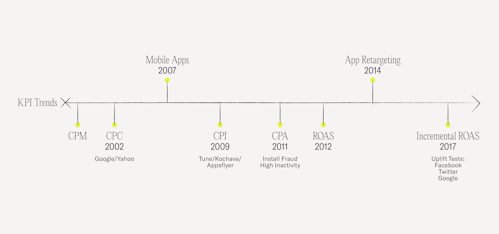The KPI shift: why you’ve got wrong app retargeting metrics
September 05, 2018

Measuring the performance and impact of retargeting campaigns can be complicated, even though it shouldn’t be. With concerns like fraud and organic conversion cannibalization, app marketers are looking for better KPIs to prove the contribution of retargeting to their revenues.
In performance marketing we’ve seen KPIs continuously evolve to be more aligned with the business objectives of advertisers by focusing on how much bang one can get for one’s buck, i.e. how much additional revenue there is at the end of the day. This trend is especially true for retargeting. App retargeting provides mobile marketers with a wealth of data about their users’ behavior and their campaigns, but it can be difficult to discern which data is most valuable when it comes to measuring success.
A look back at the history of how app marketing KPIs have evolved from CPM to CPC, to CPI, to CPA, to ROAS, and now to incremental ROAS shows us why this is the most advanced KPI to use today.

From Cost per Mille to Cost per Click (CPM - CPC)
In 2002 Google introduced AdWords, a second-price keyword auction which is billed on CPC. Yahoo followed suite shortly after.
CPM was good metric for companies that were mainly focused on branding, paying for the reach that their ad achieved in a placement. However, CPM did not measure how many website visits ads were generated. Paying for clicks became a more measurable solution; CPC minimized the discrepancy between what advertisers paid for vs. what they wanted.
From Cost per Click to Cost per Install (CPC - CPI)
The rise of mobile apps happened in 2007 shortly after the release of the first iPhone. User acquisition as a marketing channel started, followed by a surge of mobile attribution platforms starting 2009.
Paying for clicks did not guarantee install conversions. Paying for a guaranteed install became a more attractive metric for app marketers.The event tracking technology of attribution providers enabled marketers to measure the cost of each install directly.
From Cost per Install to Cost per Actions (CPI - CPA aka CPX)
Around 2014, marketers started to realize that an install doesn’t mean anything unless the user took meaningful actions within the app. The demand for app retargeting grew and people began to focus on user engagement. The cost per install metric no longer sense for re-engagement campaigns, as retargeting only has to do with after the install.
CPI was a sufficient KPI until advertisers noticed high inactivity rates coupled with increasing issues around install fraud marketers and incentivized installs, and wanted to know the cost of a new user completing a certain action (sign up / first purchase). Combined with the rising necessity of reengaging users where measuring installs no longer made sense, the cost of a specific app action became the new KPI.
From Cost per Action to Return On Ad Spend (CPA - ROAS)
As CPA only measures the cost of getting the user to perform an action but doesn’t account for its yield (whether the user purchased an expensive or a cheap item), marketers turned to ROAS for a clearer picture of their marketing campaigns’ results.
In this way, they could account for the combined impact of users who made frequent, low value purchases and users who bought higher value items, but purchased less frequently. It became more important to know the total revenue and lifetime value of users.
From ROAS to Incremental ROAS (and how this is relevant for those who want to retarget effectively)
While app marketing has become more sophisticated, the true potential of app retargeting was hard to judge because all if not most of metrics are borrowed from user acquisition. This ultimately leads to two pitfalls:
Pitfall #1
Marketers retargeting conservatively to avoid organic cannibalisation:
in other words organic conversions being wrongly attributed to a retargeting campaign. This uncertainty around the legitimacy of results leads to ineffective retargeting.
Pitfall #2
They use retargeting as an anti-churn tool and only retarget users who have lapsed:
Retargeting only those who have lapsed is essentially a waste of time. At best, it is not taking advantage of the full capabilities of retargeting. This narrow approach only harnesses a small percentage of the gains from retargeting. Lapsed users are less likely to convert and so you will often see worse results as compared to when you retarget holistically (personalized at any user stage). Retargeting should instead be seen as an add-on for increasing revenue.
The solution: Incremental ROAS is the only KPI you’ll really need to look at as an app marketer, regardless of the in-app actions you’re trying to drive. Because ultimately we’re setting out to prove and to measure one thing: how effective is retargeting driving in-app revenue?
The answer? Scientifically proven. See for yourself.





